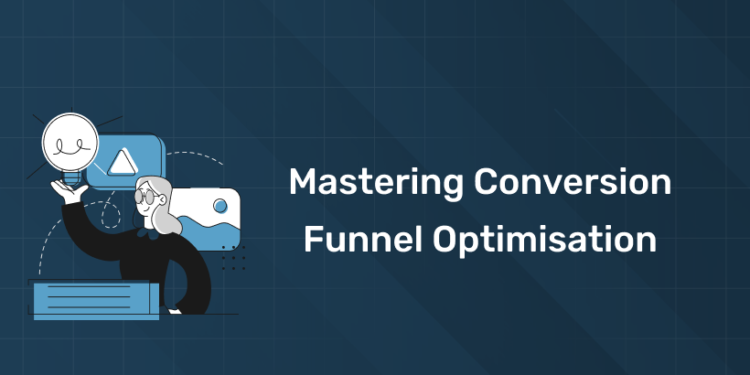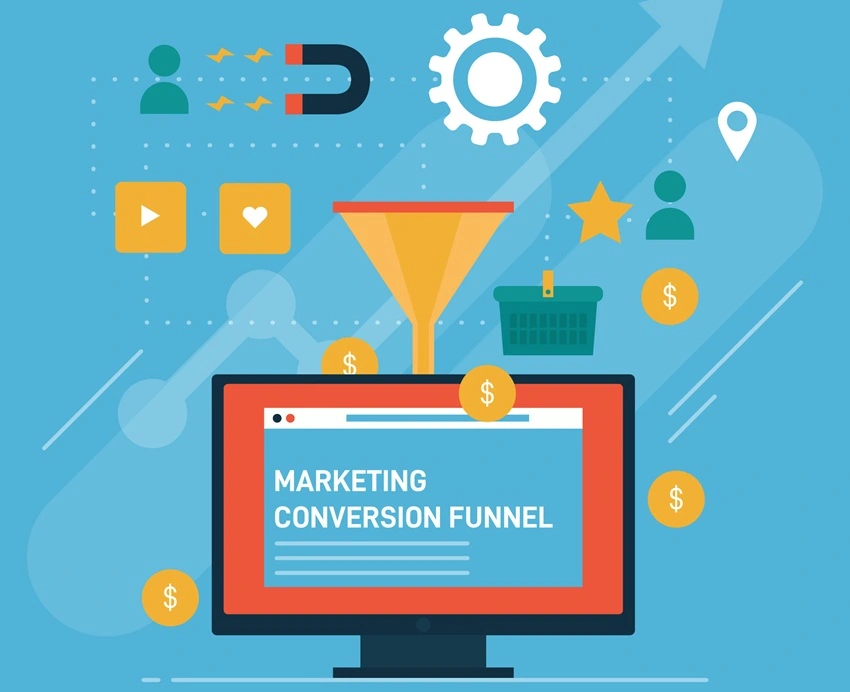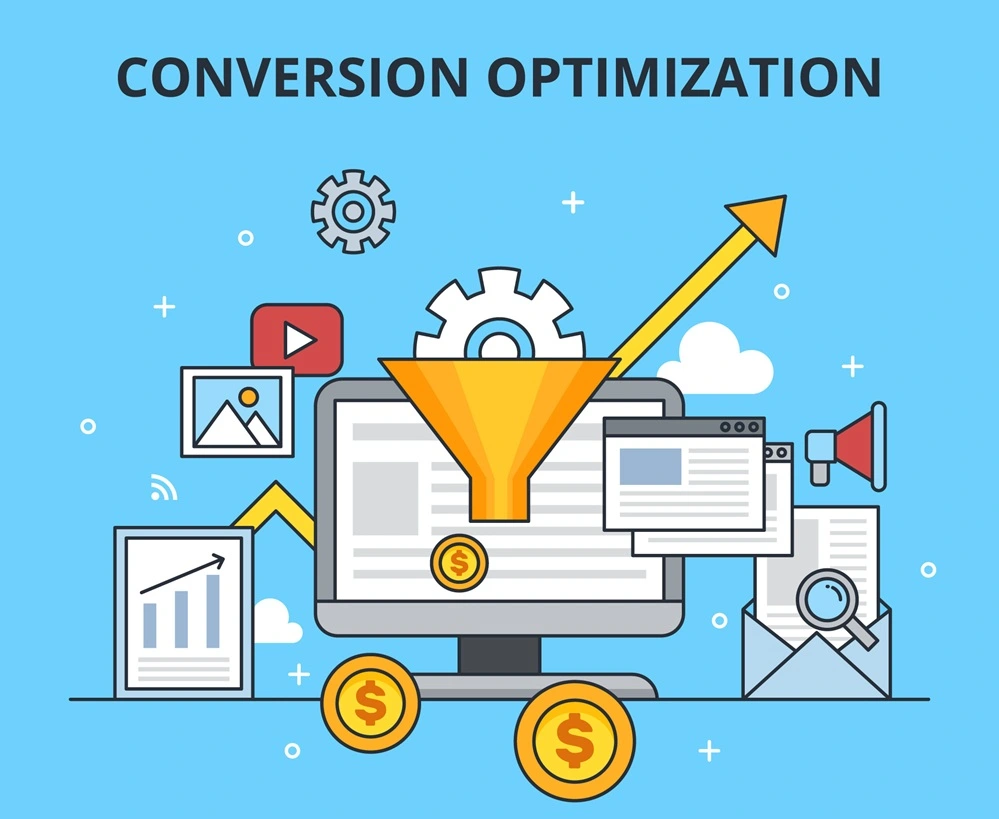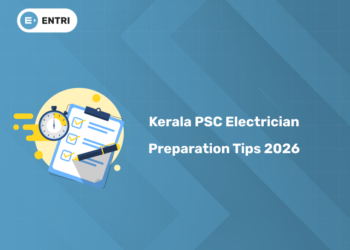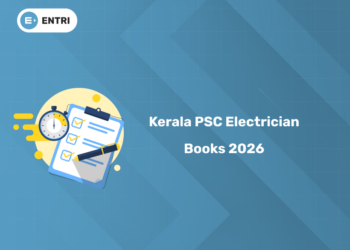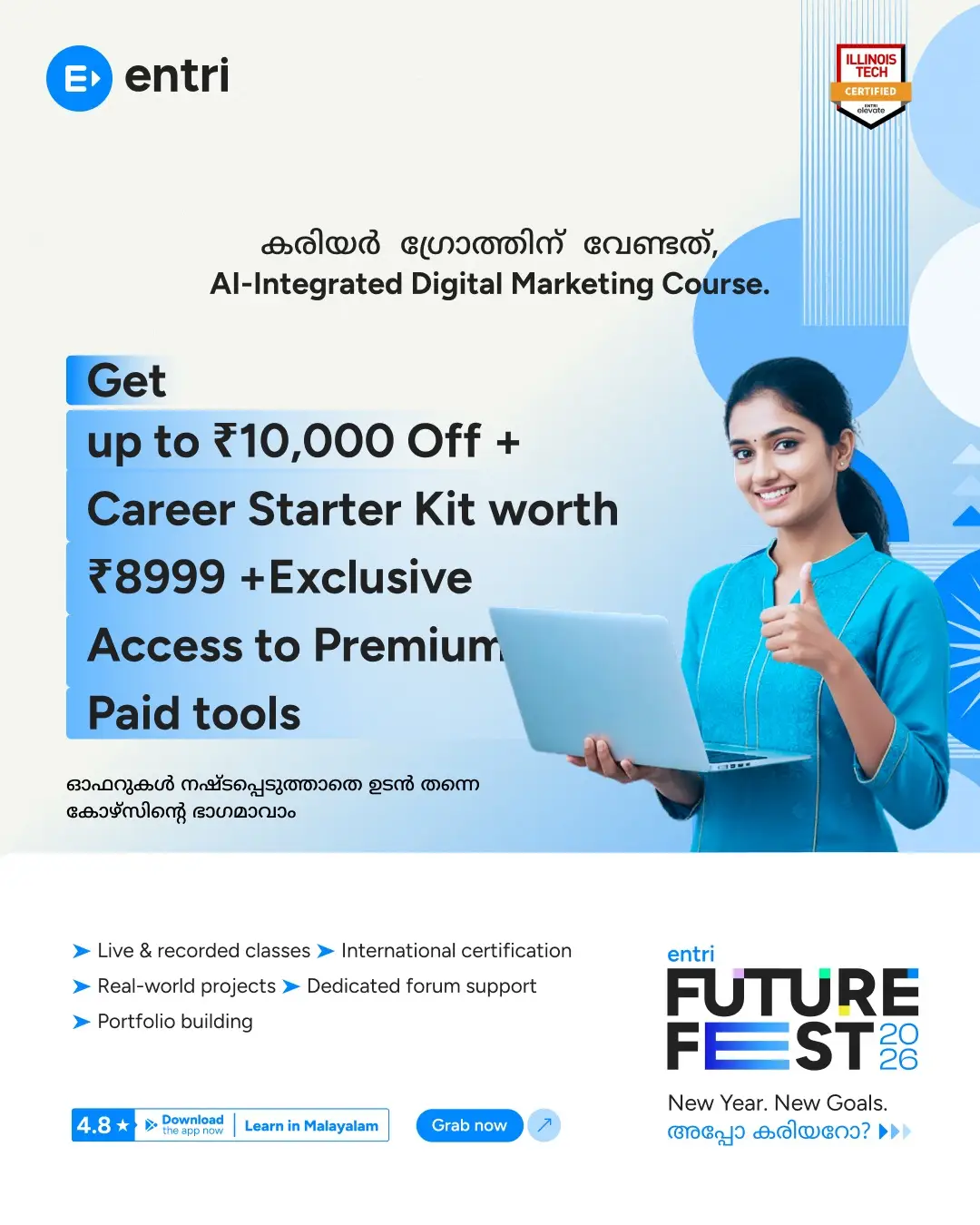Table of Contents
Building a brand from scratch ? There’s no secret to long term success like turning your audience into loyal customers – no matter how much traffic you drive to your website, if that traffic isn’t converting into sales, then your marketing efforts have been for nought.
It all comes down to – conversion funnel optimisation–
A conversion funnel is the path that guides potential customers from when they first bump into your brand to when they actually make a purchase, and optimising that funnel is vital to making sure as many visitors as possible are actually buying from you. That’s what this blog post is all about – explaining what the conversion funnel is, why it’s so important and how you can make it work better for your brand.
Join Our Online Digital Marketing Course & Learn the Fundamentals!
What is a Conversion Funnel?
A conversion funnel is just another way of saying the journey that your prospects go on as they move from hearing about your brand to making the decision to buy from you. Think of it as a sales pipeline – the top is wide with a lot of prospects, but the bottom is narrow and made up of people who are actually ready to make a buy.
The Stages of a Conversion Funnel
1: What is the primary goal of SEO (Search Engine Optimization)?
- Awareness
The top of the funnel is where your potential customers first catch wind of your brand. This is the widest bit of the funnel, where your audience gets exposed to your products and services through marketing campaigns, blog posts, social media and adverts. - Interest
Once someone knows about your brand, they move on to the interest stage where they start engaging with your content. At this point they might well subscribe to your newsletter, follow you on social media or pop by your website whenever they get a chance. - Consideration
In the consideration stage, prospects start actively looking at your product and comparing it with the competition. They might just download a free resource, sign up for a free trial or have a look at some product reviews. - Intent
The intent stage is when prospects are at the point of actually making a decision. They might well be working on adding stuff to their shopping cart, looking over any pricing details or searching for something to do with discounts or promotions. This is the bit of the funnel where your marketing efforts can really start to pay off. - Conversion (Purchase)
This is the final stop on the funnel where prospects actually turn into buying customers. They complete their purchase, and ideally your relationship with them doesn’t come to an end there. A well-optimised conversion funnel will also include some strategies around what happens afterwards to turn those customers into loyal brand advocates.
Become an AI-powered Digital Marketing Expert
Master AI-Driven Digital Marketing: Learn Core Skills and Tools to Lead the Industry!
Explore CourseWhy is Funnel Optimisation Important?
Optimising your conversion funnel is important because it lets you make the most of the amount of prospects who actually do turn into paying customers. The better your funnel is, the more smoothly you can get people moving from one stage to the next, which ultimately means you’ll be selling a lot more and getting a better return on your investment.
In short, the goal of funnel optimization is to remove friction at every stage so it’s as easy as possible for a prospect to move from one stage to the next.
Why Conversion Funnel Optimization is Important for Your Business
When you’re building a business from scratch the ultimate goal is to convert interest into sales. Here’s why funnel optimization is key to your success:
- More Conversions
The most immediate benefit of funnel optimization is it will directly increase your conversion rates. By simplifying the process and removing obstacles, more of your visitors will convert into customers. - Better ROI
Optimizing your funnel will get you more out of the traffic and leads you already have. This means a higher return on your marketing spend, even if your traffic numbers aren’t going through the roof. - Customer Insights
As you analyze and optimize each stage of the funnel, you’ll gain valuable insights into customer behavior, which will allow you to refine your marketing strategy and meet the needs of your audience better. - Higher Customer Lifetime Value (CLV)
A well-optimized funnel doesn’t just drive conversions, it also helps you nurture long-term relationships with customers. By providing value at every stage, you increase the chances of customers buying again and becoming brand advocates.
How to Optimize Your Conversion Funnel: A Step-by-Step Guide
Optimizing your conversion funnel is an ongoing process of testing, analysis and refinement. Here’s how to do it:
Step 1: Analyze Your Funnel’s Current Performance
Before you can optimize your funnel, you need to know how it’s performing. Track the performance of each stage using tools like Google Analytics, Hotjar or a funnel tracking software. Key metrics to look at are:
- Traffic: Always check how many visitors are entering your funnel?
- Bounce Rate: Are people leaving your site too soon?
- Conversion Rate: How many visitors are moving to the next stage or buying the product?
- Exit Rate: Where are people dropping off in your funnel ? Check each page.
This will give you a baseline and help you identify which parts of the funnel need the most attention.
Step 2: Optimize the Awareness Stage
The awareness stage is all about getting traffic to your website or landing page. To optimize this stage:
- Create Great Content: Blog posts, videos, podcasts, and infographics that provide value to your audience. The more useful and shareable your content, the more traffic it will attract.
- Use SEO: Use SEO strategies to improve your search rankings and make it easier for people to find your content. Keywords, backlinks, and site speed all help.
- Use Social Media & Paid Ads: Reach a bigger audience through organic social media and paid ads. Make sure your ads are targeted and well-crafted to attract the right prospects.
Step 3: Interest Stage
Once people are aware of your brand, the next goal is to spark interest. To optimize this stage:
- Content: Offer more in-depth content like case studies, webinars, and eBooks. This gives more value to your audience and nurtures their interest.
- UX: Make your website easy to navigate. A clean, simple design with clear CTAs will keep visitors engaged.
- Email: Build an email list and send personalized content or offers. Drip campaigns can be super powerful in moving users to the next stage of the funnel.
Step 4: Consideration
At this point prospects are considering your product or service. To optimize this stage:
- Social Proof: Show testimonials, reviews, and case studies to build trust. People will buy if they see others have had good experiences.
- Demos or Trials: Let users try your product. Free trials, demos or product samples are powerful ways to get prospects to take the next step.
- Comparison Pages: Help prospects compare your offering to your competitors, show them why your product is the best.
Step 5: Conversion
This is the final stage, where prospects become paying customers. To optimize conversions what you can do is:
- Simplify Checkout: Checkout should be as smooth as possible with easy navigation. Reduce the number of steps, offer multiple payment methods, and no surprises in between.
- Discounts and Incentives: If applicable, offer discounts or promotions to get people to buy and should be visible in the checkout page.
- Urgency and Scarcity: Always create fomo. Use countdown timers or limited stock notifications to create urgency, get visitors to buy sooner.
Step 6: Post-Purchase Nurturing
After a customer buys, don’t stop there. Post-purchase nurturing is key to turning one-time customers into repeat buyers.
- Follow-Up Emails: Send personalized thank-you emails and upsell or cross-sell additional products.
- Loyalty Programs: Offer rewards for repeat purchases or referrals.
- Feedback: Ask for customer feedback and reviews, which can help you improve your offerings and build brand loyalty.
Become an AI-powered Digital Marketing Expert
Master AI-Driven Digital Marketing: Learn Core Skills and Tools to Lead the Industry!
Explore CourseHow the Entri AI-Powered Digital Marketing Course Can Help You Optimize Your Funnel
The Entri AI-Powered Digital Marketing Course is a great resource to learn how to optimize your conversion funnel. The course covers everything from SEO to advanced paid ad strategies and conversion rate optimization (CRO).
Here’s what Entri’s course will help you:
- Customer Behavior: Learn to track and analyze customer behavior at each stage of the funnel. The course goes deep into data analytics and customer journey mapping so you can optimize your funnel based on real data.
- Conversion Rate Optimization (CRO): The course covers best practices for CRO at every stage of your funnel, from awareness to post-purchase nurturing.
- AI-Powered Tools: Learn to use AI tools to automate tasks, analyze data and personalize the customer experience which can supercharge your funnel.
Key Takeaways
- The Conversion Funnel: A conversion funnel – that journey your potential customers go through to go from being aware of your product to actually handing over their cash – can be broken down into stages like Awareness, Interest, Consideration, Intent, and then that all-important Conversion.
- Getting Your Funnel Running Smoothly: To really make your conversion funnel work, you need to be looking at how it’s performing, making it more user-friendly, making the checkout process as painless as possible, and not forgetting to build some loyalty with customers who’ve already spent their cash with you.
- Why This Matters: Getting your funnel optimised is a big deal – it can make a real difference to how many sales you get, how much profit you make on each one, and how valuable a customer is to your business over the long term – basically, you want customers who’ll keep coming back for more.
- Entri’s AI-Powered Digital Marketing Course: That’s where the Entri course comes in – they offer a comprehensive course that goes into the nitty-gritty of conversion funnel optimisation and teaches you how to use AI to get real insights and make real improvements to your funnel’s performance.
Conclusion
Optimising your conversion funnel is key to building a successful brand. By streamlining each stage of the funnel and adding value at every touchpoint, you can turn more visitors into customers, more sales and grow your business.
The Entri AI-Powered Digital Marketing Course is the perfect place to learn the techniques and strategies for funnel optimisation. With its full curriculum, hands-on experience, and AI-driven tools, you’ll have everything you need to take your brand to the next level.
Frequently Asked Questions
What is conversion funnel optimisation in digital marketing?
Conversion funnel optimisation is the process of improving each stage of the customer journey, from awareness to action, to increase conversions and revenue efficiently.
Why is conversion funnel optimisation important for businesses?
It helps identify where users drop off, improves user experience, and maximises conversions without increasing ad costs, making your marketing more efficient.
What are the key stages of a conversion funnel?
The main stages include Awareness, Interest, Decision, and Action, often abbreviated as AIDA. Each requires different strategies and content types.
How can I identify where my funnel is leaking?
Use analytics tools like Google Analytics or Hotjar to monitor user flow and find pages with high bounce or drop-off rates. These indicate friction points.
What tools can help in conversion funnel optimisation?
Popular tools include Google Analytics, Hotjar, Optimizely, HubSpot, and Mailchimp for tracking, testing, and automating funnel improvements.
How do I increase conversions at the bottom of the funnel?
Simplify checkout processes, add social proof, offer incentives, and use clear calls to action (CTAs). Focus on trust and ease of decision-making.
Can small businesses benefit from conversion funnel optimisation?
Absolutely. Even small tweaks, like better headlines or clearer offers, can lead to significant improvements in conversion rates for small businesses.
How often should I optimise my conversion funnel?
Regularly. Review performance at least once a month and run A/B tests continuously to ensure you’re adapting to customer behaviour and market changes.
What skills are needed to master conversion funnel optimisation?
You need a mix of data analytics, content strategy, UX design, and customer psychology, all of which are covered in Entri’s AI-powered digital marketing course.
Where can I learn conversion funnel optimisation step by step?
You can enroll in Entri’s AI-powered Digital Marketing Course, which offers practical, hands-on training in funnel design, analytics, and automation with placement assistance.


